Nigerian jollof rice, or "party jollof" is a one pot, tomato and pepper infused rice with a layer of crispy rice at the bottom. My husband is Nigerian, and this recipe is from my sister-in-law. It's packed with flavor, and just needs 30 minutes!
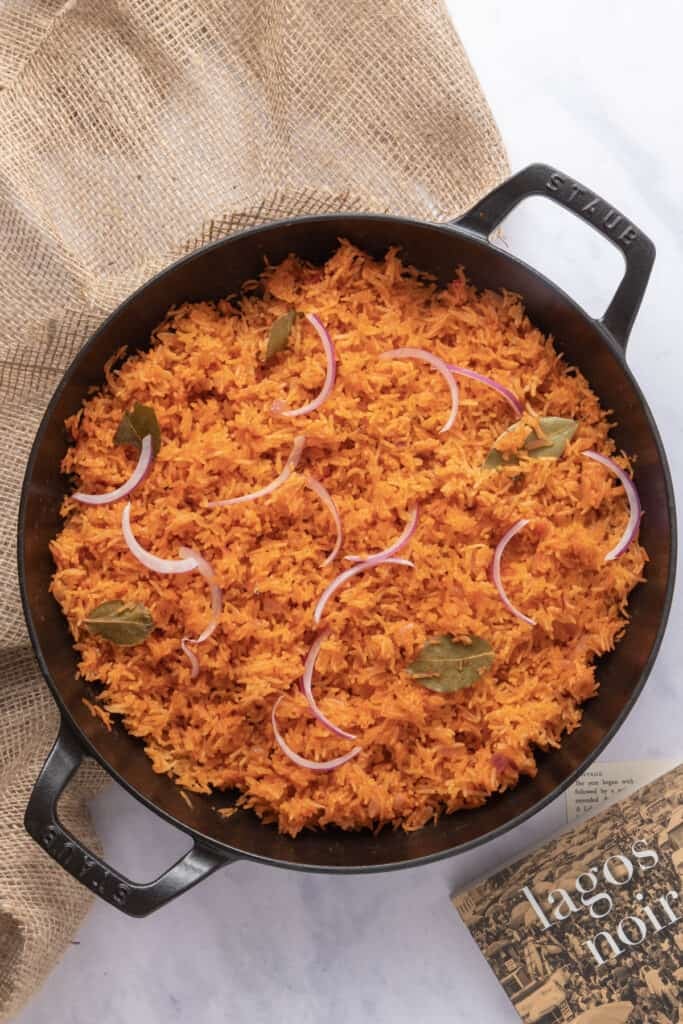
This post contains helpful tips and tricks! If you're in a rush, please use the "Jump to Recipe" below!
💭 Why you'll love this recipe
My partner is from Lagos, Nigeria, and considers any dish without meat an affront to his existence. As a dutiful Yoruba spouse and lifelong vegetarian, I wanted to find a Nigerian dish we could both enjoy. Thankfully, I didn't have to look too far!
- Ready in 30 minutes. This recipe comes together in barely any time and it is so delicious, and hearty! If you want an Instant Pot version, check out this Instant Pot Jollof Rice.
- Great for make-ahead meals. I typically make a huge batch and we tend to eat it with different curries and mains through the week. It also freezes excellently.
- Versatile and super simple to customize. You can easily adjust the spice levels, use whatever rice you have on mind, or adjust the spice base with flavors that are more familiar.
⭐ What is Jollof Rice?
Jollof rice is a West African red pepper rice, similar to dirty rice in the South. As Portuguese trading posts were set up on the Senegal River Delta, tomatoes made their way to West Africa. This recipe originated in Senegal, from the Wollof people. It's commonly believed that a shortage of barley led a local cook to use rice, and modern-day jollof rice was born (Benachin, aka, one pot).
One school of thought suggests that the influence of jollof rice has been felt in the American South, where West African slaves from rice-growing regions introduced the "red rice" concept. Modern-day dishes like jambalaya and gumbo are believed to derive some influence from jollof rice! So, this recipe lays out the connection between West African cuisine and modern-day Southern "red" cuisine.
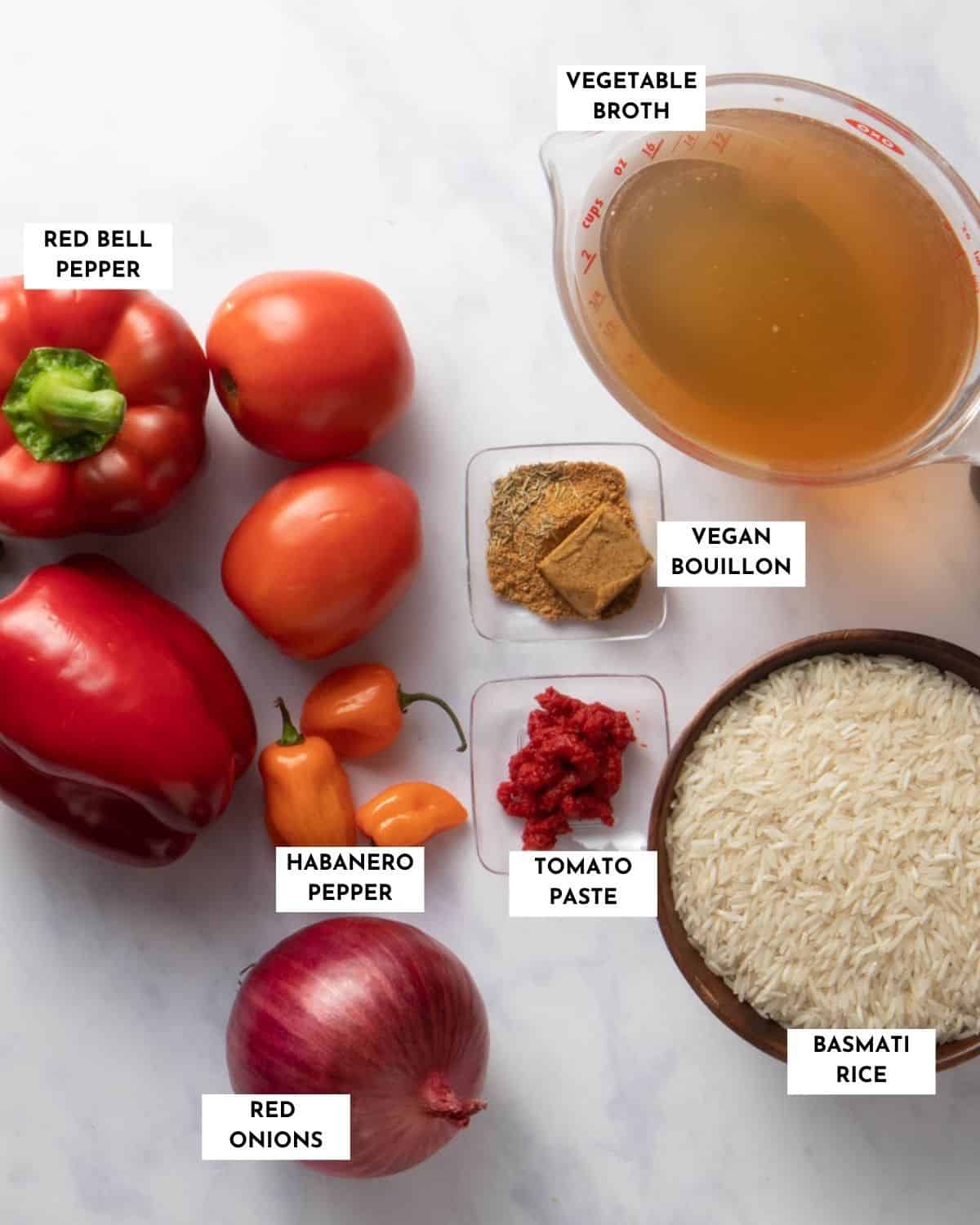
Notes & Variations
- Scotch Bonnet vs. habanero pepper: The traditional Nigerian recipe uses Scotch Bonnet pepper. But that can sometimes be hard to find, but habanero pepper works just as well. To adjust the spice levels, you can remove the seeds of the pepper, or simply leave it out. It still tastes delicious!
- No blender? No problem. Though unconventional, you can actually just use marinara sauce and add some habanero sauce (blasphemous, but you gotta get by sometimes) My sister-in-law runs a catering business in Nigeria and she was the one who gave me this tip!
- Use long grain parboiled rice. Parboiled rice is a type of long-grain rice that has been partially cooked before milling. This process gives it a firmer texture and makes it less likely to become sticky. If you can't find parboiled rice, you can use regular long-grain rice, but be sure to rinse it thoroughly before cooking.
- Use a good quality tomato paste. Tomato paste is one of the key ingredients to make Nigerian Jollof Rice, so it's important to use a good quality product. Look for a tomato paste that is 100% tomatoes and without added sugar or salt. If you don't have tomato paste, check out these tomato paste substitutes (including tomato sauce, crushed tomatoes).
Nigerian vs. Ghanaian Jollof Rice
There is a ton of debate on where jollof originated, and which jollof rice is the best (sparking online wars). But I'll say - jollof rice, to me, is a dish that every household has their own recipe for. It's like a Thanksgiving turkey, or cornbread. And my jollof rice is based on my sister-in-law's recipe (aka, it's the real deal).
There are a couple of key differences between Nigerian and Ghanaian jollof.
- Nigerian jollof uses long grain, parboiled rice (most commonly consumed). Ghanaian jollof uses softer, non-parboiled rice (typically something like jasmine rice)
- Ghanaian jollof also has a wider variety of spices (I've eaten some with clove, for instance) - but Nigerians keeps it simpler (typically just bouillon).
📋 Ingredients & Notes
What is the best rice for jollof?
This is a raging debate! The most common options are long-grain rice, basmati rice, and Thai jasmine rice. There's a trend towards bulgur as a healthy option. Traditional long grain rice tends to hold the consistency the best, but I prefer basmati because it cooks a bit softer. For the oven, Thai jasmine works best.
♨️ Make the best Nigerian Jollof rice
Blend roughly chopped red peppers, fresh tomatoes, onions and habanero peppers to make the base sauce. I use this sauce directly to make jollof.
If you have time and want to intensify the flavor, you can parboil the base to evaporate excess water to make the Nigerian pepper sauce. You can make this in a big batch and have it on hand almost all the time. If you go this route: use around 200 ml (80% of a cup) per 2 cups of rice.
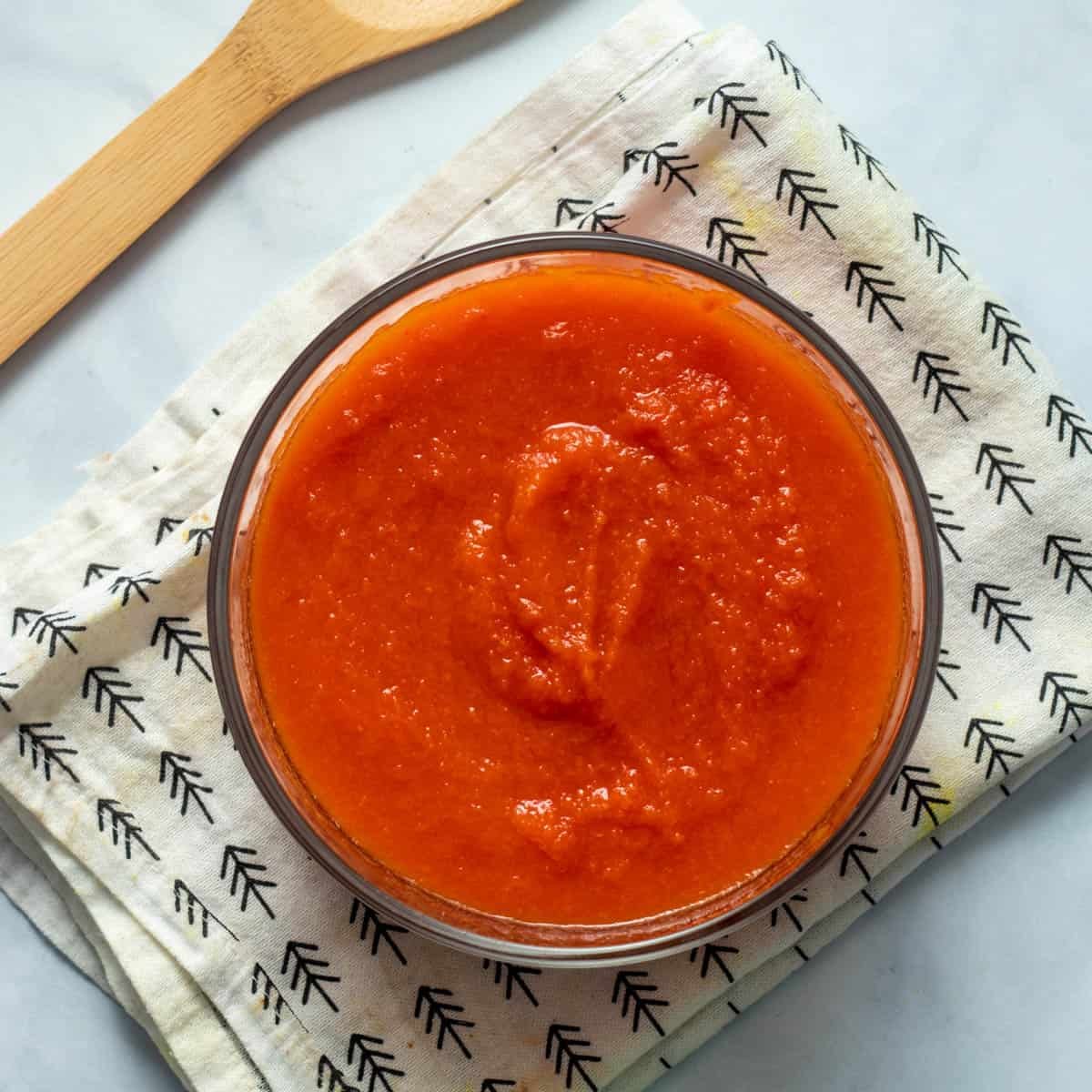
Sauté some onions and bay leaves, then add the base sauce to fry it. Use a deep and wide pan with a tight-fitting lid. Add about ⅓ cup of vegetable oil (this seems like a lot but you're going to basically fry off the sauce).
Add chopped onions and fry for 1-2 minutes. Then, add bay leaves and thyme and sauté for a minute.
Now, add the tomato paste, tomato base, and bouillon and fry the sauce. At this step, you can also add curry powder if you wish. But the key is to get the base sauce nicely fried with the onions and spices. I cook this covered for 1 to 2 minutes to get the raw taste out of the pepper sauce.
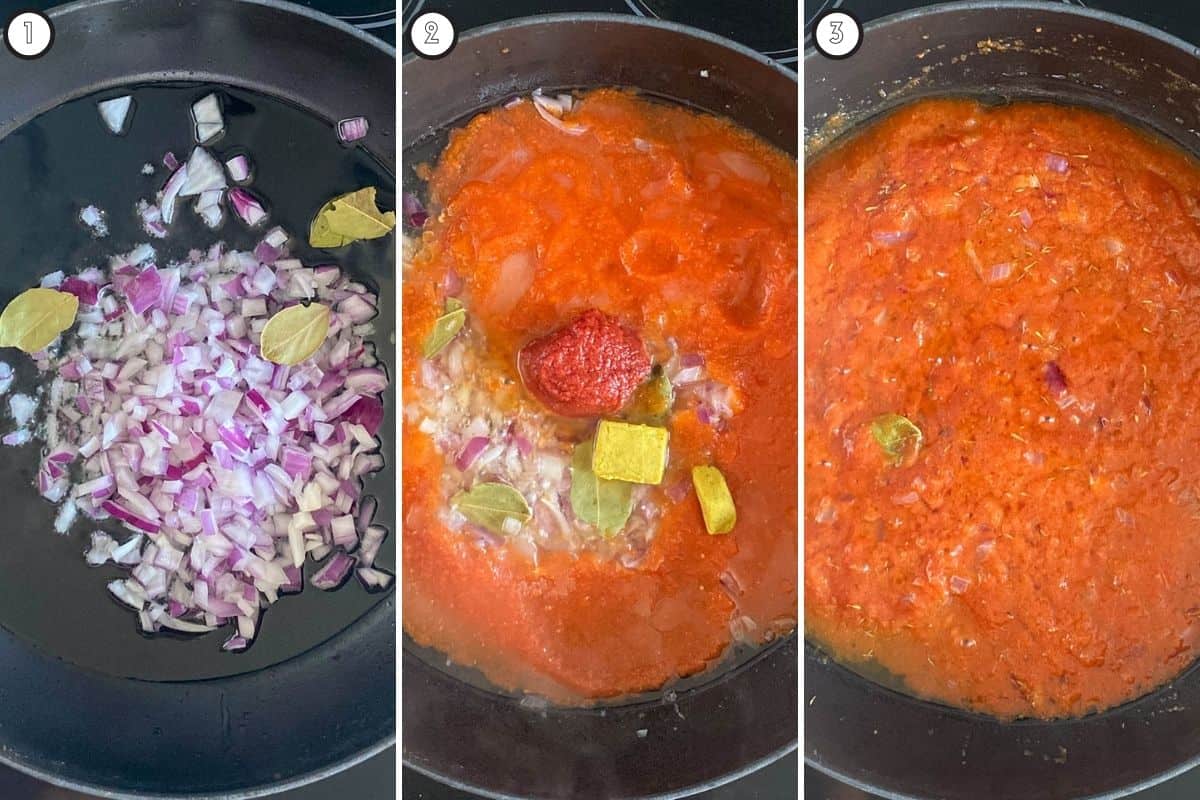
While the sauce is cooking, rinse your rice thoroughly. Not rinsing rice properly is one of the biggest mistakes that leads to mushy jollof! So, rinse the rice under cold water really well (typically 3 times until the water runs clear).
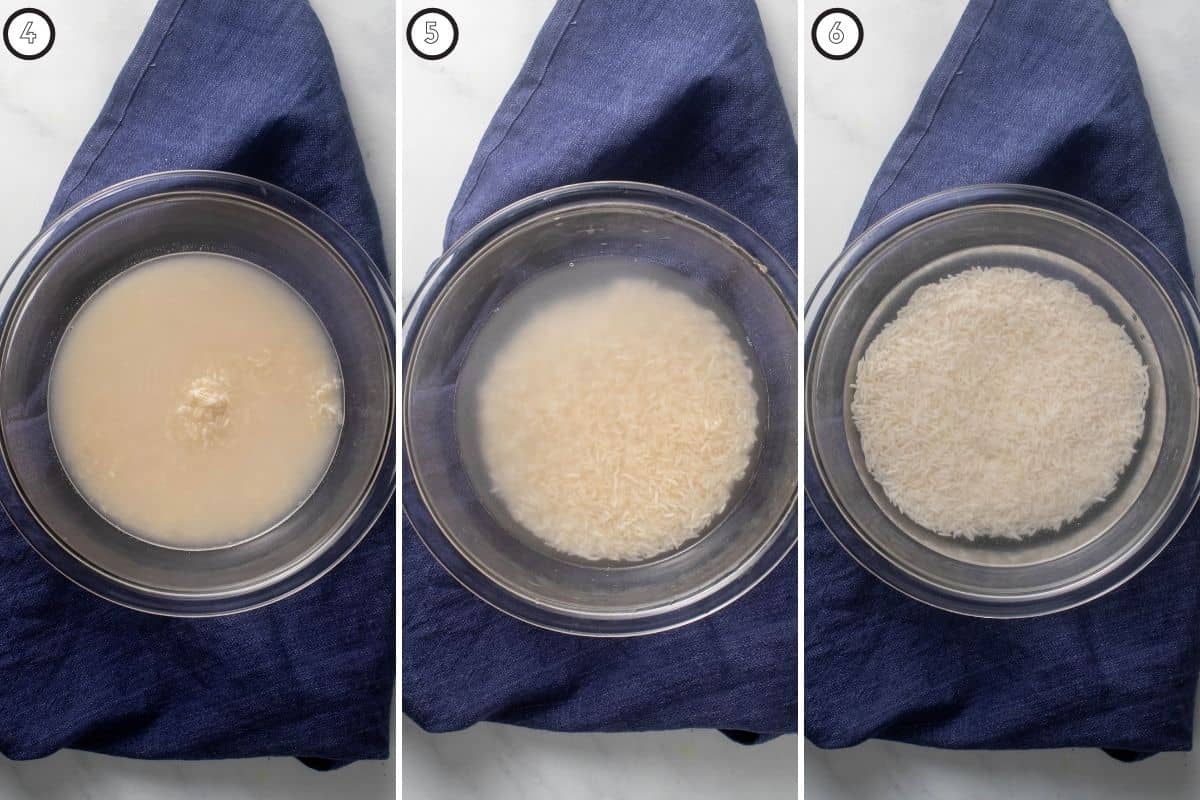
Now, add the broth (if you're using 2 cups of rice, use 1 and ¾ cup of broth) to the pepper sauce. Add salt, and if you wish, black pepper or white pepper to taste. I use vegetable broth, but you can also use chicken any other stock you have. The broth usually has some salt, so watch how much salt you use.
Cover the lid and increase the heat to a medium-high and boil. Typically, this takes about 3 to 4 minutes.
Add the rinsed rice to the pot and give it a good stir so it's evenly distributed. Cover with tight-fitting lid and cook covered for at least 12 minutes.
Once the rice is rinsed, add this to the pot and give it a good stir so it's evenly distributed. Cover with the tight-fitting lid and cook covered for at least 12 minutes.
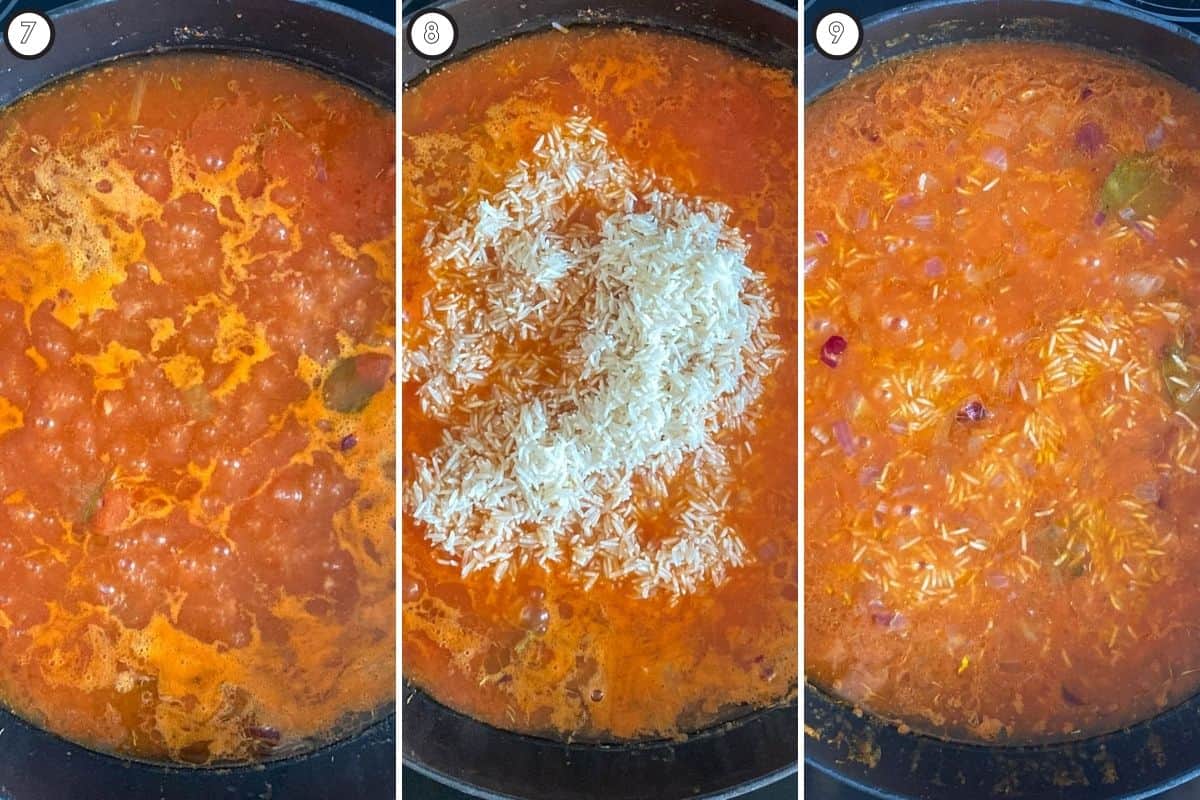
Check at the 12 minute mark to see how fluffy your rice is, and give it a good mix again. Cook for another 2 to 3 minutes until the rice is fully cooked. Move it off the heat, open the lid and let it vent the steam for a few minutes. Serve hot!
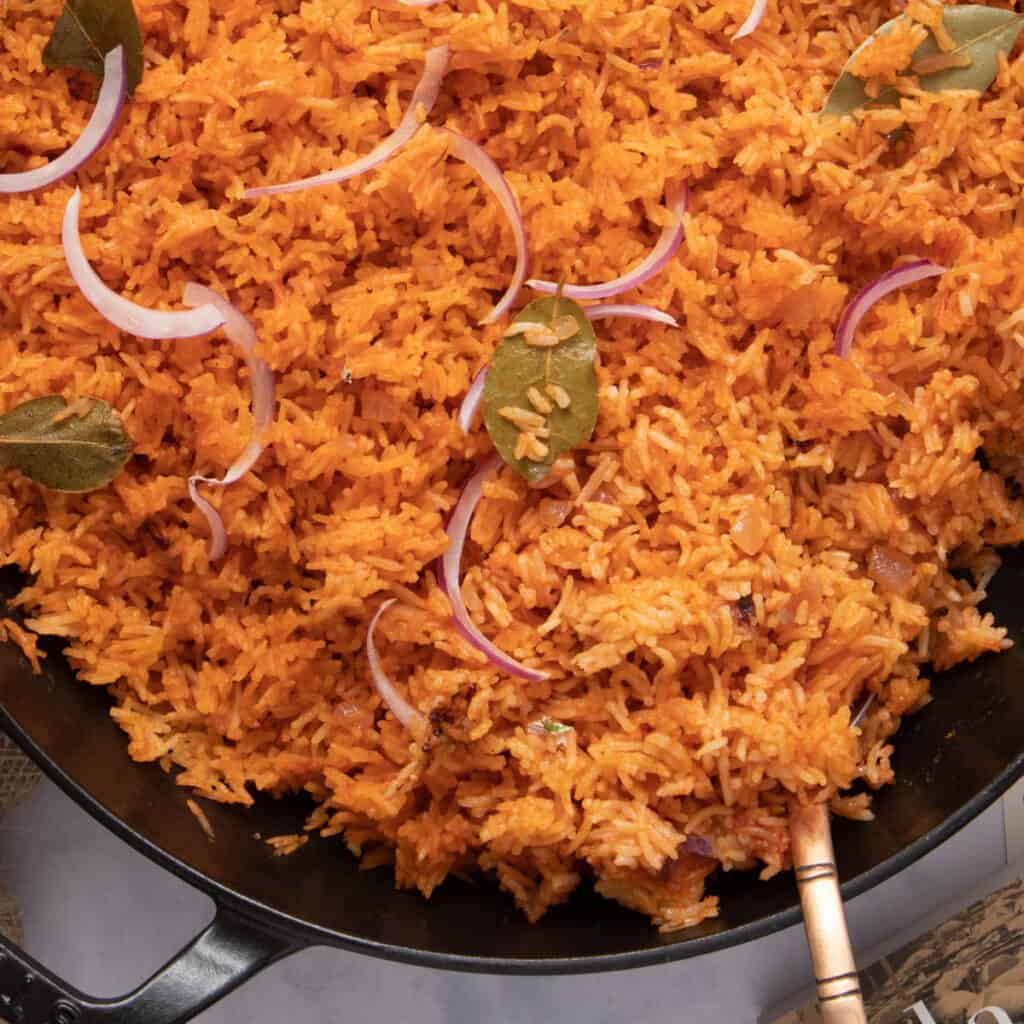
How do you adjust the spice level?
The pepper sauce is the heart of any Jollof rice recipe. But every person's spice palette is different. If you have low spice tolerance, play safe the first time and then increase the peppers the next time, versus the other way around.
- To intensify flavors, you can parboil the sauce (i.e. simmer on low heat for about 30 minutes) to get a more concentrated flavor. This is the base which we use for making a variety of dishes (like vegan red pepper alfredo or my vegan Nigerian efo riro).
- To reduce the pepper flavor, play with the mix of tomatoes and red peppers, or eliminate the habanero peppers entirely.
🍴 Three tips for perfect Nigerian jollof rice
- Wash your rice first! Extra starch can turn the rice super mushy if you're not careful about it. Typically, I measure the rice into a mixing bowl, fill it with COLD water, and use my hands to wash the rice. I typically wash it twice before I cook it.
- Use 1:1 water to rice ratio, and cook on medium heat. Jollof rice uses steam infusion to cook - not boiling. You don't want to overcook the rice! Some people use aluminum foil in addition to a tight fitting lid but this is optional.
- Check your rice halfway through the cook time. I typically check my jollof rice halfway through and give the rice a good stir before closing the lid again. This makes sure that you're not burning any of the bottom rice. Fluffy, delicious jollof.
- Don't overcrowd the pot. It's important to give the rice enough room to cook evenly. If you overcrowd the pot, the rice will steam instead of fry, and it won't be as flavorful.
🧾 Troubleshooting FAQs
This classic Nigerian jollof rice is built on my sister-in-law's recipe and has taken me nearly a year, and several attempts to perfect. But thankfully, I was able to troubleshoot some common problems so hopefully you don't have to.
There are two common problems - the rice burns, or it gets too mushy. Here are tips for preventing or salvaging the dish if that happens.
If your rice is starting to burn when you check on the 10 minute mark (i.e. there's no water left, but it's raw and not cooked yet) - then add a bit of boiling hot water, cover the pot with aluminum foil, turn the heat to high for a minute, and then take off the heat. The residual heat will cook the rice without burning it further. I would say, use about ⅓ cup of water for every 2 cups of rice. Leave it covered for 10 to 15 minutes and check again.
Party rice has a smoky flavor, and is scorched at the bottom so you get crispy rice. This is normal (and included in the steps of the recipe). If you don't want that to happen, I suggest an extra tablespoon of oil, and a bit of water after stock. More liquid, less chance of burning.
Always make sure you rinse the rice first, and remove the excess starch. When you steam cook like you do with this dish, the extra starch can overcook and make the rice mushy. If your rice is already mushy or sticky, get it off the heat ASAP. This stops the cooking. Then, drain excess water, and transfer cooked rice to a flat dish (e.g. baking sheet). Spread it out and let it cool (~30 minutes at room temperature). Finally, use a paper towel to blot excess water, and pop the baking sheet in the oven at 350F for 10 minutes. Mushy jollof rice, salvaged.
🍴 Serving and storage suggestions
Typically, Nigerian jollof rice is served with meat or stews (like this Efo Riro). As a vegetarian, I sometimes serve it with vegan drumsticks, or even this sheet pan aloo gobi. Don't come after me!
To store jollof rice, just wait for it to cool down completely, throw it in an airtight container and put it in the fridge. It'll stay well for at least 3-4 days. You can just microwave the portion of the rice you want to eat when you want to eat it.
Freezing is also super simple. First make sure that the rice is completely cooled down, then put it in an airtight container. When you're ready to eat, make sure you thaw the rice first, then spread in a baking sheet, and throw it in the oven (15 minutes at 350F after it comes to room temperature).
More Nigerian and African vegetarian recipes:
If you loved this Nigerian Jollof Rice, try these other recipes:
📖 Recipe
Nigerian Jollof
Ingredients
For the stew base
- 2 red bell peppers, diced
- 2 Roma tomatoes, quartered
- 1-3 habanero peppers, diced, adjust to taste
- ½ red onion
For the jollof rice
- ⅓ cup vegetable oil
- ½ onion, diced
- 2-3 bay leaves
- 1 tablespoon tomato paste, for the color - you can make do without
- 2 bouillon cubes, make sure to buy a vegan version!
- ½ teaspoon thyme, substitute thyme powder as needed
- 1 teaspoon salt, add more to taste as needed
- 2 cups long grain rice, wash and drain to get rid of excess starch
- 1 ¾ cups stock
Instructions
Pepper Sauce
- Blend tomatoes, red peppers, onion and habanero peppers in a blender until you get a smooth puree. This is the base of the Jollof rice.
Jollof Rice
- In a deep pot, heat the vegetable oil over medium heat. Add diced onion and bay leaves to heated oil and fry for 2-3 minutes
- Once onions are translucent, add pepper sauce, thyme, bouillon and tomato paste for color. Cook for 3-4 minutes until the raw smell of the pepper sauce disappears.
- Add stock, cover, and bring to a boil (covered). Add washed and drained rice, mix with the sauce, and lower heat to a low-medium.
- Now, cover the pot (either with foil first or just a tight fitting lid) and simmer for 10 minutes. At the 10 min mark, stir the rice so it doesn't stick. Check to see how the rice is cooked. Cook for another 2 to 4 minutes to finish cooking the rice.
- If you want the bottom to be crispy, turn up the heat to medium high for 1 minute
- Take the pot off the heat, and stir up the crispy rice at the bottom to the top. Add a few more slices of onion and serve hot!
Video
Notes
- Typically, Nigerians use long grain rice (and not aromatic rice like basmati) to make jollof. However, I've found that basmati rice works as a great substitute since it's meant for "infusion" cooking (i.e. when you cook the rice in a flavorful sauce or broth like in this case). Plus, I couldn't resist adding a bit of my own heritage into the mix here!
- It's easy to adjust this recipe to your taste - if you want it more spicy, add another habanero pepper; if you want it less spicy, avoid it altogether. Every person's spice palette is different, but if your spice tolerance is lower, I'd suggest playing safe the first time and then increasing the peppers, versus the other way around.






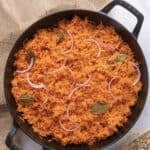








Seriously good yum. I started on the stove to fry the onion and the sauce, then finished it in the rice cooker and it came up great. Sacrificed the crispy bottom 🙁 but avoided burning the rice 🙂
Went great with beans and "fried egg" (thin tofu strips brushed with curry powder and kala namak [black salt]). But I have a lot of other ideas to use it.
OMG!! This Nigerian Jolof Rice recipe has me drooling! I can't wait to cook up a big pot of this deliciousness and share it with all my loved ones.
Great recipe! I always had trouble getting the bottom to crisp and not burn but your tips were super helpful and I nailed it! Delish!
It was my first time making this Nigerian Jollof rice and I'm glad I gave it a try! Sooo good and delicious!
Wow this was tasty! The crispy bottom was definitely our favorite part.
Omgggg this was SO GOOD. I used basmati rice. The crispy layer on it was AMAZING - we loved it!
Made this last week. Easy and delicious. Everyone loved it. Thanks so much, Shruti!
I substituted red palm oil for vegetable oil and loved the recipe. I am happy I have a baseline I can tweak to my liking. It's been hard being vegetarian with Nigerian family, I'm thankful she did the work for me making vegetarian versions.
Thank you so much! Super happy you loved the recipe.
I make this dish at least twice a month (or twice a week sometimes) and this is my favorite vegan recipe of this dish! It tastes just like how I remember jollof rice tasted. Very delicious and would highly recommend this recipe!
Thank you so much, Kevin! That's so great to hear 🙂
It's amazing right?
Hello,
Really loving the recipe. I just wanted an idea of how cook the dish in a rice cooker. I am a bachelor and i find easier to make the rice in it.
Please let me know. Thank you Again
Hey Mojiz! Thanks for the note. Rice cooker is a bit tough for this recipe, since it needs to basically steam cook through infusion and pressure cooking makes it a bit mushy. Let me test this out a bit and then I can share back!
Please do. Thank You
Tried the Effo Riro and that went down a treat. This gave me the confidence to try Jellof rice and though it went a little mushy - I’m glad your trick of leaving it out and in the oven worked wonders. My husband loved it and I’m so in love with your recipes. On to the next one!
So glad you enjoyed it Samira! Sorry to hear it turned out mushy at first though. I find it's so hard to predict the specific types of rice that one might have access to (for instance, I tried making this for my parents in India, and though I used "basmati" rice there as well, it turned out a bit more dry than the ones I'm used to in the US!) Super glad that the oven trick worked though 🙂
I finally made it to the store and bought the ingredients for the Jollop Rice.
It was easier than I thought. I was a little confused by the recipe because there were so many instructions.
This is a crave worthy recipe. It has a yummy flavor different than other rice I’ve tried. I will make this again with a little more heat. I used a large jalapeño and took out the seeds. I’m not a vegan so I used chicken broth.
I’ll try one of the dal recipes tomorrow.
Thanks so much Coreen! I'm so glad you enjoyed the recipe - if there are any parts that were especially confusing, please do let me know and I can try to add more detail to the instructions!
I have bookmarked this recipe and it is the only one I use to cook consistent, delicious Jollof for my Nigerian partner and I. It is also a crowd pleaser- I’ve tripled it and cooked for a crowd of 10 and they looooved it. I’ve tried so many different joloff recipes and this is the only one that always delivers!!
This is a fab recipe - simple, heartwarming and delicious. Will definitely be making this again😋
This was amazing. The rice was perfect - the rinsing makes all the difference! And the flavors blended together perfectly. I used 3 habaneros with seeds removed and it was perfect for our family.
OH MY GOONIES! I made this a few weeks ago (sorry I never posted a review). Made it again this week! Sooooooooooo good! The flavors and the texture and the...EVERYTHING. So good! Thanks for sharing this recipe.
My daughter said, "Mommy you nailed it!" Thanks for the recipe. We had it with your Efo Riro recipe along with some plantain. That dinner was oh so delicious!
And you made my day! 🙂 My partner is Nigerian, and this is one of his favorite recipes (funnily, with efo riro and fried plantain) - super glad you (and your daughter!) liked it!
I am really keen on making this recipe, but please may I ask what 2 cups of rice is in grams and 1 cup 3/4 in millilitres please?
Hi Demi! Thanks for the question - it's approximately 400 grams of basmati rice, and 415 ml of water or stock! I use a rough conversion of 200 grams per cup of basmati rice 🙂 I'll update the recipe to have the measurements coded in - hope you love it!
This recipe is amazing! So delicious and pretty easy to make. I will definitely be adding this to my regular rotation!
I also added chickpeas, chopped peppers, and frozen peas and carrots for some extra veg and they went really well!
Thank you Haile! The idea to add chickpeas and other veggies is great - will be trying that out myself next time!
I’ve made this again last night but this time I added leftover zucchini, broccoli, and frozen edamame and it was awesome 😊
That's awesome!! Super glad to hear this 🙂 Thanks for letting me know!!
This is a great recipe. My family loved it. I made it with basmati rice and half a scotch bonnet(without the seeds) In place of the habanero.
Thank you! Glad to hear that.
Absolutely loved making this sauce! The versatility of this sauce (which is bursting with flavour btw) can not be overstated - it can literally go with anything. I used it to make pasta and am planning to save the leftovers for these rice. Yum!! Already excited!
Thanks, Qandeel! So glad you liked the recipe - let me know if you use it any other way and how it turns out 🙂
This recipe is the easiest I've ever tried. There are many out there but this is simple and delicious. Thanks so much for sharing oxox
Thanks so much Kristen!! So glad you liked it 🙂
I was sceptical trying to find an online recipe that tasted authentic. But I'm so glad I chose this one. I swapped a couple things out (Groundnut oil, Maggie cube, Scotch bonnet) but the rice was near enough perfect. Will be my go to recipe.
Thank you so much for sharing this recipe! I made Jollof Rice for the first time today and it came out amazing!
I am so glad you liked it!